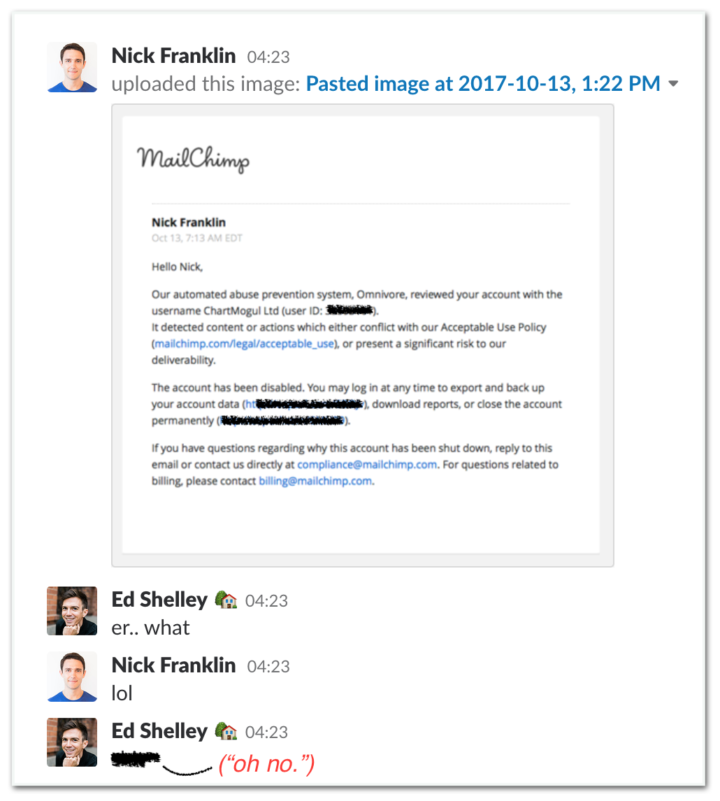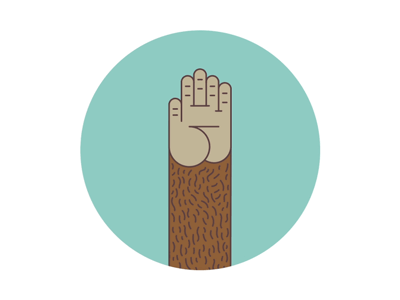Okay, first of all a confession: I haven’t quite sent the one hundredth edition of the SaaS Roundup newsletter yet — it’s coming this Friday. But I doubt my insights will change much in the next couple of days, and I wanted to share these insights as part of the one hundredth edition, so here we go. Make sure you’re subscribed so you receive it!
It’s easy to feel like a weekly newsletter is a table stakes feature of any B2B marketing organization in 2017. Everyone’s got one — why would you question starting your own?
At ChartMogul we sent our first edition of SaaS Roundup on September 4th, 2015, to just under 200 recipients.
Today, the weekly email goes out to over 10,000 people and is a primary channel for engaging with our audience at ChartMogul.
Along the way we’ve gone through deliverability problems, massive subscriber culls and of course, crippling self-doubt. We’ve even had our account mistakenly suspended once:

1. Be profoundly clear on the value proposition
One of the biggest mistakes I see marketers making today is that they dive into creating newsletters and other content projects with the feeling that it’s basically a non-decision to do it. Everyone has one so we should have one too, right? WRONG!
Walking into projects without going through the steps of justifying, clarifying and planning out WHY you’re doing them is a sure fire route to mediocrity. And mediocrity is worse than failure, because it’s not an endpoint — you’ll just keep going. Ask yourself:
- Why should I publish a newsletter?
- What do I have to offer people that’s of value?
- Why would people want to hear from me every week?
- Why would they want my newsletter over someone else’s?
Answer the above questions first, and be clear on your value proposition.
Further reading: I’ve spoken several times about treating content as a product. This is a useful concept with newsletters too.
2. Nurture the health of your list
“I’d love to have millions of subscribers, but I’d much prefer to have tens of thousands of engaged readers who open and read my newsletter each week.”
In the land of vanity metrics, newsletter subscriber count is right up there. It’s no more useful than pageviews or other traffic-based metrics you’ll find in Google Analytics.
In fact, having a large number of unengaged — or zombie — subscribers to your email list can actually cause far more problems than in the web world. You run the risk of getting punished for spam, getting demoted to the “Promotional” tab in Gmail and generally hurting deliverability. Also, you can save some money on that MailChimp bill!
I’d love to have millions of subscribers, but I’d much prefer to have tens of thousands of engaged readers who open and read my newsletter each week.
We unsubscribed 17% of our unengaged audience last year, and we’ll soon be repeating the task this year.
Further reading: MailMunch has a great guide on this practice.
3. Be respectful of people’s time
“It’s almost a default position after a successful project: ‘Great! Let’s scale it into something bigger!’ We couldn’t have been more wrong.”
Very early on in the life of SaaS Roundup, we decided that the core value proposition of the newsletter was to save people time — to provide an alternative to scouring the web for the truly high-quality reads in the SaaS universe. As a result of this, we chose a hard limit for the number of items to share in each edition — just our top three external articles.
As the newsletter grew solidly in the year since its launch, we excitedly thought about how we could expand its content, to grow it into something bigger. It’s almost a default position after a successful project: “Great! Let’s scale it into something bigger!” We couldn’t have been more wrong.
We polled subscribers on all the shiny new things we might want to include in the newsletter. The response? They didn’t want anything new, and liked it exactly as it was, thankyouverymuch.
It was after this, and some discussions with subscribers at SaaS conferences, that I realized that original value proposition — of saving people’s time — resonated so strongly with our audience that they saw any kind of expansion as an attack on this.
Lesson learned: People deeply appreciate a respect for their time (or lack of time).
4. Put. Actual. Effort. Into. It. (It will show)
“It’s the same kind of appreciation you feel for a product, when you can feel the amount of sweat and thought put into every interaction.”
I think a short email newsletter is often seen as a low-effort way to reach people on a recurring basis. After all, it’s a simple email that gets written once and pushed to thousands of people. This is a huge misunderstanding.
I always grossly underestimate the amount of time it’ll take me each week to gather the resources and recommendations I include in SaaS Roundup. The reality is that we’re doing all of the work of cutting out the noise, so that our readers don’t have to. Getting from literally thousands of blog posts, articles, reports and guides to a top three list is no small task.
I really believe that people can sense the effort, and appreciate the quality and attention to detail. It’s the same kind of appreciation you feel for a product, when you can feel the amount of sweat and thought put into every interaction.
Bonus advice: Feed readers are an invaluable tool for scaling your content curation efforts. Use a tool like Feedly and build your list of respected publishers.
5. Substance (content) always beats style
Email frontend design is a special kind of mess, in which our visions of beauty get wrangled through a half-baked editor and spat out the other end with erroneous empty HTML tags and broken layout.
Fortunately, the email inbox forces an absolute focus on text content. So much so that many marketers are pivoting to an almost entirely text-based format for their emails. My advice would be to not go any further than light branding and basic typography when it comes to your newsletter design. Your audience (and your frontend engineer) will probably thank you.
(We are working on that design refresh for SaaS Roundup, though. It’s coming.)
6. Add your personal voice
“What did you think of the article you’re linking to? What did you learn? Nobody else in the world will be able to copy that.”
After speaking to our audience over the last couple of years about SaaS roundup, I’ve learned the two key values they appreciate in our newsletter. One was mentioned above (brevity), while the other was not really by design and somewhat unexpected: personal voice.
There are thousands of newsletters available, many of them sharing “curated” content. On a basic level, we do the same! While the word “curated” has been used to death at this point, it’s worth looking at what curation means exactly:
“In contemporary art, the title curator is given to a person who selects and often interprets works of art. In addition to selecting works, the curator often is responsible for writing labels, catalog essays, and other content supporting the exhibition.”
I love this description of the role because it goes far beyond the pure “selection” aspect. It’s about adding your own voice or interpretation.
One simple thing you can do to make your newsletter unique, is add a personal touch to the content you share. What did you think of the article you’re linking to? What did you learn? Nobody else in the world will be able to copy that. And nobody likes interacting with a faceless brand or corporation!
Further reading: SaaS Content Marketing: Finding Your Voice and Building an Audience (on SaaScribe)
7. Burn the playbook; form a habit
“We completely ignored the playbooks by making SaaS Roundup a Friday newsletter.”
Habits are powerful things in the design of user experience and software. All of the big tech platforms go incredibly deep on the science of habit-forming products. But actually, we can all achieve a little bit of this in the newsletter we send each week.
At ChartMogul we’ve found habit to be more important than the frequently-touted playbooks when it comes to sending mass email.
According to the playbooks, you shouldn’t send an email at the end of the week as people are wrapping up for the weekend. We completely ignored the playbooks by making SaaS Roundup a Friday newsletter. The result? Frequently our subscribers tell me they look forward to reading it over their weekend morning coffee. We built a habit.
Be consistent. Get that email out on the same day and roughly the same time each week, whatever it takes. Schedule it if you’re going to be offline, or find a guest to do it if you’re really away. Just get it out!
Add a visual identifier. Pick a single emoji, and include it at the beginning of your subject line every week. Humans are far better at recognizing imagery over text, which is why we have icons in software and favicons in our browser tabs. Your emoji will stand out in an inbox full of text-based email.
These elements when combined help build a strong habit among subscribers. Before long, they’ll be waiting on that emoji to show up in their inbox every Friday morning (or whenever you send your email).
Further reading: Hooked: How to Build Habit-Forming Products by Nir Eyal
To those of you whose inboxes we reach every Friday, thank you. Here’s to another hundred editions!

